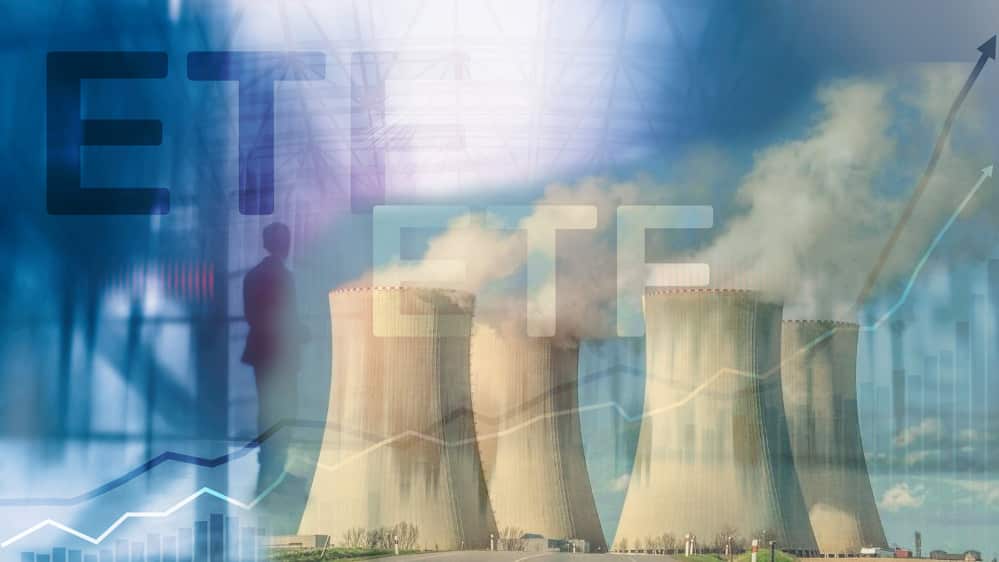
Uranium is a raw material used in nuclear energy generation. The actual commodity cannot be purchased or owned because of its radioactive nature. Investing in companies actively involved in the mining and synthesis processes is the best approach to benefit from its global price swings. The price of uranium is rising. The majority of the price increase in the last five years has been fueled by a renewed global quest for alternative energy sources. However, in recent months, a new source of assistance has surfaced. Sprott Physical Uranium Trust, which was just established, began purchasing large quantities of the material.
What are nuclear ETFs?
Nuclear energy exchange-traded funds (ETFs) invest in companies involved in uranium mining, nuclear power plant construction, nuclear energy generation, and nuclear power industry service providers. Nuclear ETFs have $2.09 billion in assets under management, with three ETFs trading on the New York Stock Exchange. The cost-to-income ratio is 0.72% on average.
With $1.28 billion in assets, the Global X Uranium ETF URA is the largest Nuclear ETF. The best-performing Nuclear ETF in the previous year was URNM, which returned 83.92 percent. The North Shore Global Uranium Mining ETF URNM, which was launched on March 12, 2019, was the most recent ETF in the nuclear area.
Why should you invest in nuclear energy ETFs?
Popular renewable energy sources like solar and wind suffer from inconsistency. Even without widespread implementation, nuclear energy currently meets 10% of worldwide electricity demand. One uranium pellet may generate enough electricity to power a ton of coal, three barrels of oil, or 17,000 cubic feet of natural gas.
TerraPower, a nuclear innovation business founded by Bill Gates, is constructing its first nuclear power station in Wyoming. TerraPower and X-Energy, a nuclear reactor and fuel design engineering company have received a $160 million investment from the US Department of Energy.
Nuclear power accounts for 70.6 percent of France’s energy and 20 percent of the UK’s. China, the world’s greatest emitter of greenhouse emissions, has set aside more than $400 billion to develop 150 new nuclear reactors by 2040. There are only 440 nuclear reactors in the entire world to put this in perspective.
Nuclear power is part of the Biden administration’s clean energy plan in the United States. The American Nuclear Infrastructure Act, which was reintroduced in June 2021, aims to grow the nuclear energy sector in the United States. The US Department of Energy committed $61 million on nuclear R&D projects across the country in June 2021.
Best nuclear Energy ETFs
Global X Uranium ETF (URA)
The URA, which was founded in 2010, is up 66% in 2021. It is the largest uranium ETF currently available. The fund invests in a group of roughly 40-45 companies active in uranium mining and nuclear component manufacturing.
Uranium producers in Canada and Kazakhstan are the fund’s top holdings. Cameco (NYSE: CCJ) and NexGen Energy (NYSE AMERICAN: NXE), both Canadian uranium miners, are among its top three holdings, as is Kazakh miner KazAtomProm. Cameco accounts for 23% of the fund.
Also, the assets of the Global X Uranium ETF are almost entirely international. Canada has half of the net assets, followed by Australia (11%) and Kazakhstan (9%). The United States is only slightly more than 5% of the total.
North Shore Global Uranium Mining ETF (URNM)
The URNM was launched in 2019 and is the second-largest uranium ETF. It is primarily focused on uranium mining firms, but it will also invest in companies that own the physical element. URNM’s assets, like URA’s, exploded in 2021, rising from around $48 million at the end of 2020 to nearly $540 million.
With only 35 holdings at the moment, it is concentrated, primarily foreign portfolio. It’s also somewhat top-heavy, with Cameco and Kazatomprom accounting for 14.9% and 13.3% of assets, respectively; single-stock risk is more of a two-headed beast than it is with URA.
As previously stated, the Sprott Physical Uranium Trust possesses physical uranium. Paladin Energy, an Australian production company, and Yellow Cake, a Channel Islands-based company that buys and keeps uranium oxide, make out the top five holdings in the uranium ETF.
VanEck Uranium+Nuclear Energy ETF (NLR)
The NLR was launched in 2007. It is distinct from the two uranium ETFs, URA, and URNM. URA and URNM primarily invest in uranium miners, whilst NLR focuses on nuclear energy utilities. Utilities account for 84% of the fund’s holdings.
Four of NLR’s 26 properties are shared by URA and NLR. NLR primarily invests in the US and Japanese companies, with Duke Energy (NYSE: DUK), Dominion Energy (NYSE: D), and Exelon Corp. as its top three holdings (NASDAQ: EXC). NLR underperformed its miner-investing counterparts due to its overexposure to utilities.
Sprott Physical Uranium Trust (UU)
Sprott also provides a direct investment in uranium if you don’t want to invest in miners. The Sprott Physical Uranium Trust is the world’s largest physical uranium fund. This closed-end fund may be purchased through most major brokerage firms. It could also be to blame for much of the recent rise in uranium prices.
With almost $629 million in assets under management, the fund offers an exchange-traded take on spot uranium, is off to a strong start. The Sprott Physical Uranium Trust bought 100,000 pounds of U3O8 on its first day of trading (38.5 tU). It held a total of 18,194,658 pounds by market closing.
Conclusion
This year, a small segment of the commodities market is going nuclear. Nuclear Energy ETFs have hit a tipping point. There are many reasons why you should invest in them. For example, atomic energy currently meets 10% of worldwide electricity demand and is the most reliable since we cannot rely on other renewable sources like the sun and wind. The best nuclear energy ETFs to invest in is Global X, North Shore Global Uranium, VanEck Uranium+Nuclear Energy, and Sprott Physical Uranium Trust.







